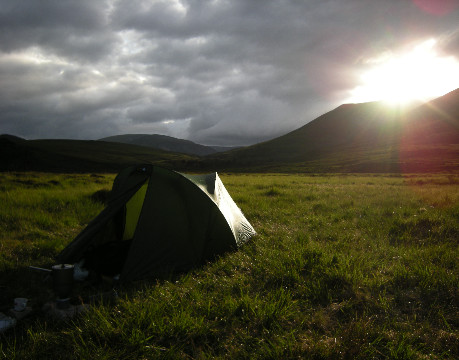Thursday 16th March 2017, 11:02am
As the days lengthen and the temperatures begin to creep up, many folk turn their attention to summer hillwalking.
Scotland enjoys some of the most enlightened access opportunities in the world, but the right of access exists only if it is exercised responsibly. The Scottish Outdoor Access Code gives full details of rights and responsibilities for those seeking access, as well as for landowners and managers, but here’s a quick guide to some of the things we can do to make sure we act responsibly.
Wild camping
Spending a few days out in Scotland’s hills can be a wonderful way to extend your trip, perhaps enabling you to reach more remote summits, or simply enjoying the experience of living in the landscape. Access rights extend to wild camping, i.e. camping that is lightweight, done in small numbers, and only for two or three nights in any one place. Please note that the emphasis is on ‘wild’ - avoid causing problems by not camping in enclosed fields, keeping away from roads and buildings, and being careful not to disturb deer stalking or grouse shooting. The emphasis of responsible wild camping should be on leaving no trace of your visit. Here are some practical guidelines to help you achieve this:
Read more about wild camping here.
Footpath erosion
Sadly, the popularity of some of Scotland’s hills means that some footpaths and popular ways up and down the hills continue to be increasingly eroded by trampling boots. You can do your bit to help reduce further erosion in a couple of ways:
If you use a path, sticking to the middle of it may be best as that at least avoids walking along the edges of the existing path. Walking along the edges can lead to further path widening through the trampling of the vegetation and subsequent soil erosion.
Walking well away from the path may be an option to reduce erosion. This can have the effect of “spreading the load” across the hill and may help reduce localised erosion.
Dogs
Many people enjoy the freedom of the hills with their four-legged companions, and the right of responsible access extends to dog walking provided that dogs are kept under proper control. As a dog walker, your main responsibilities are:
Ground nesting birds
Hillwalkers should be aware of their potential impact on ground nesting birds, particularly during spring, and keep an eye out for signs of nesting activity. Instinctively, most ground nesting birds are likely to respond to passing walkers in the same way as they cope with potential predators i.e. so long as walkers do not remain in the area of the nest, the parent bird(s) are likely to either remain on the nest or return to it quickly once the walker has passed.
Keep an eye out for any signs that you may be near a nest site, for example a bird displaying repeatedly to divert your attention away from a nest, or an obviously agitated bird. If you think you may be close to a nest, be especially careful where you place your feet. Be especially careful when selecting a wild camping site to ensure you do not interfere with a ground nesting bird.
Where to find out more
You can find lots more useful information relating to responsible access on our website as well as wild camping advice. It is also worth reviewing the Scottish Outdoor Access Code, taking particular note of the sections on wild camping, human waste and litter. Mountaineering Scotland also has useful leaflets relating to reducing our impact in the hills , and toilet/hygiene matters.

Wild camp in the Cairngorms.